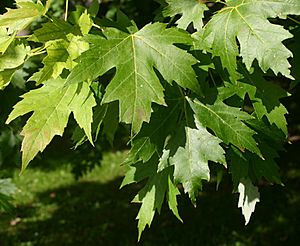Acer kenaicum facts for kids
Quick facts for kids Acer kenaicum |
|
|---|---|
| Scientific classification | |
| Genus: |
Acer
|
| Species: |
kenaicum
|
Acer kenaicum was an extinct type of maple tree. We know about it from fossils of its leaves and a special kind of seed called a samara. These fossils were found in Oligocene rocks in central coastal Alaska, USA. Acer kenaicum is part of a group of maples called Rubra, which still has living members today.
Contents
Discovering Acer kenaicum
Scientists found Acer kenaicum by studying two fossil leaves and one fossil samara. These fossils came from different places in Alaska where rocks from the Early Oligocene period are exposed. The Oligocene was a time long ago, about 34 to 23 million years ago.
One leaf and the samara were found at a place called Redoubt Point. This area is part of the Tyonek Formation, which is a layer of rock. Another leaf was found in Tsadaka Canyon, which is part of the Tsadaka Formation. Even though many fossil leaves were looked at from Redoubt Point, only one A. kenaicum leaf and one samara were found. Only one A. kenaicum leaf was found at Tsadaka Canyon.
Studying the Fossils
The main fossils used to describe A. kenaicum are called "type specimens." The most important leaf fossil from Redoubt Point is called the holotype. The samara from Redoubt Point and the leaf from Tsadaka Canyon are called "paratypes." All these fossils are "part slab" fossils, meaning they are preserved on a piece of rock.
These special fossils are kept in the National Museum of Natural History. This museum is part of the Smithsonian in the United States.
Two paleobotanists, who are scientists who study ancient plants, examined these fossils. They were Jack A. Wolfe from the United States Geological Survey and Toshimasa Tanai from Hokkaido University in Japan. In 1987, Wolfe and Tanai published their findings about A. kenaicum. They wrote about it in a science journal called Journal of the Faculty of Science, Hokkaido University.
How it Got its Name
The name kenaicum comes from the type locality where the fossils were found. This area is part of the Kenai Group of rocks in Alaska.
Based on the features of the leaves and fruits, Wolfe and Tanai thought that Acer kenaicum might be an ancient ancestor of the modern Acer saccharinum, which is also known as the silver maple.

What Acer kenaicum Looked Like
The leaves of Acer kenaicum were simple, meaning they were a single blade, not divided into smaller leaflets. They had veins that spread out like fingers from the base, and they were generally oval-shaped.
The leaves had five main lobes, which are the rounded or pointed parts of the leaf. The two upper side lobes were about two-thirds as long as the middle lobe. The side lobes were shaped like triangles, while the middle lobe was more oval. Each leaf had five main veins, with smaller veins branching off them.
The samara, which is the winged seed of the maple, had a slightly puffed-up nutlet (the part that holds the seed). The veins on the wing spread out smoothly and rarely joined together. The nutlet was oval with a rounded tip. It was about 3.0 centimeters (1.2 inches) long, and the wing was about 1.4 centimeters (0.55 inches) wide.
Maple trees usually have paired samaras. For A. kenaicum, these paired seeds were attached at a 25-degree angle. Each wing had seven veins that started from where the seed was attached and ran all the way to the end of the wing.

